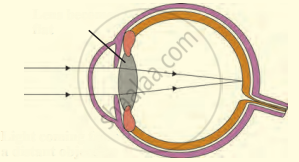Advertisements
Advertisements
प्रश्न
State the function of each of the following parts of the human eye:
(i) Cornea
(ii) Iris
(iii) Pupil
(iv) Retina
Millions of people of the developing countries are suffering from corneal blindness. This disease can be cured by replacing the defective cornea with the cornea of a donated eye. Your school has organised a campaign in the school and its neighbourhood in order to create awareness about this fact and motivate people to donate their eyes after death. How can you along with your classmates contribute in this noble cause? State the objectives of organising such campaigns in schools.
उत्तर
Following are the functions of the different parts of the eye:
(a) Cornea: The cornea controls and focuses light into the eye. It contributes 65%–75% of the eye's focussing power.
(b) Iris: The iris regulates and controls the amount of light entering the eye by automatically adjusting the size of the pupil according to the intensity of light that the eye receives. It also gives colour to the eye.
(c) Pupil: The pupil expands or contracts to regulate the amount of light entering the eye.
(d) Retina: The eye lens converges the light rays to the retina. The retina has large number of light sensitive cells. When the light falls on the retina, the light sensitive cells of retina get activated and generate electric signals. The retina send these signals to brain and gives sensation of vision.
We can contribute in this noble cause by inviting people from our families and localities to come in the program and by motivating them to donate their eyes after death. The objective of organising such campaigns in schools is to spread awareness in the society about the donation of eye and to motivate people for this noble cause.
APPEARS IN
संबंधित प्रश्न
The region of the vertebrate eye, where the optic nerve passes out of the retina, is called the
(a) fovea
(b) iris
(c) blind spot
(d) optic chaisma
To focus the image of a nearby object on the retina of an eye:
(a) the distance between eye-lens and retina is increased
(b) the distance between eye-lens and retina is decreased
(c) the thickness of eye-lens is decreased
(d) the thickness of eye-lens is increased
Why does the eye-lens not have to do all the work of converging incoming light rays?
Name two animals having eyes:
one the sides of the head.
Name the following:
The pigmented circular area seen in the eye.
State the Function:
Choroid coat in the eye
Write the name.
The fleshy screen behind cornea.
Write an Explanation.
Farthest distance of distinct vision
The following figure show the change in the shape of the lens while seeing distant and nearby objects. Complete the figures by correctly labelling the diagram.

Vitreous humour is present between ______.
